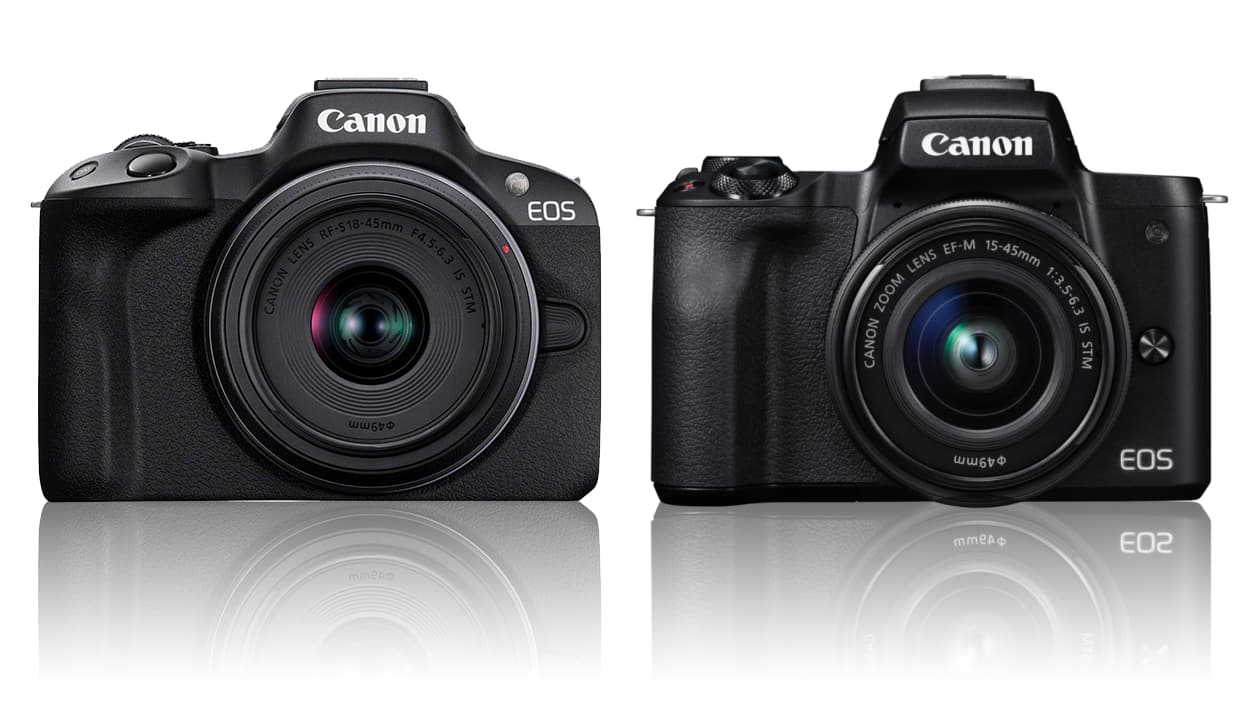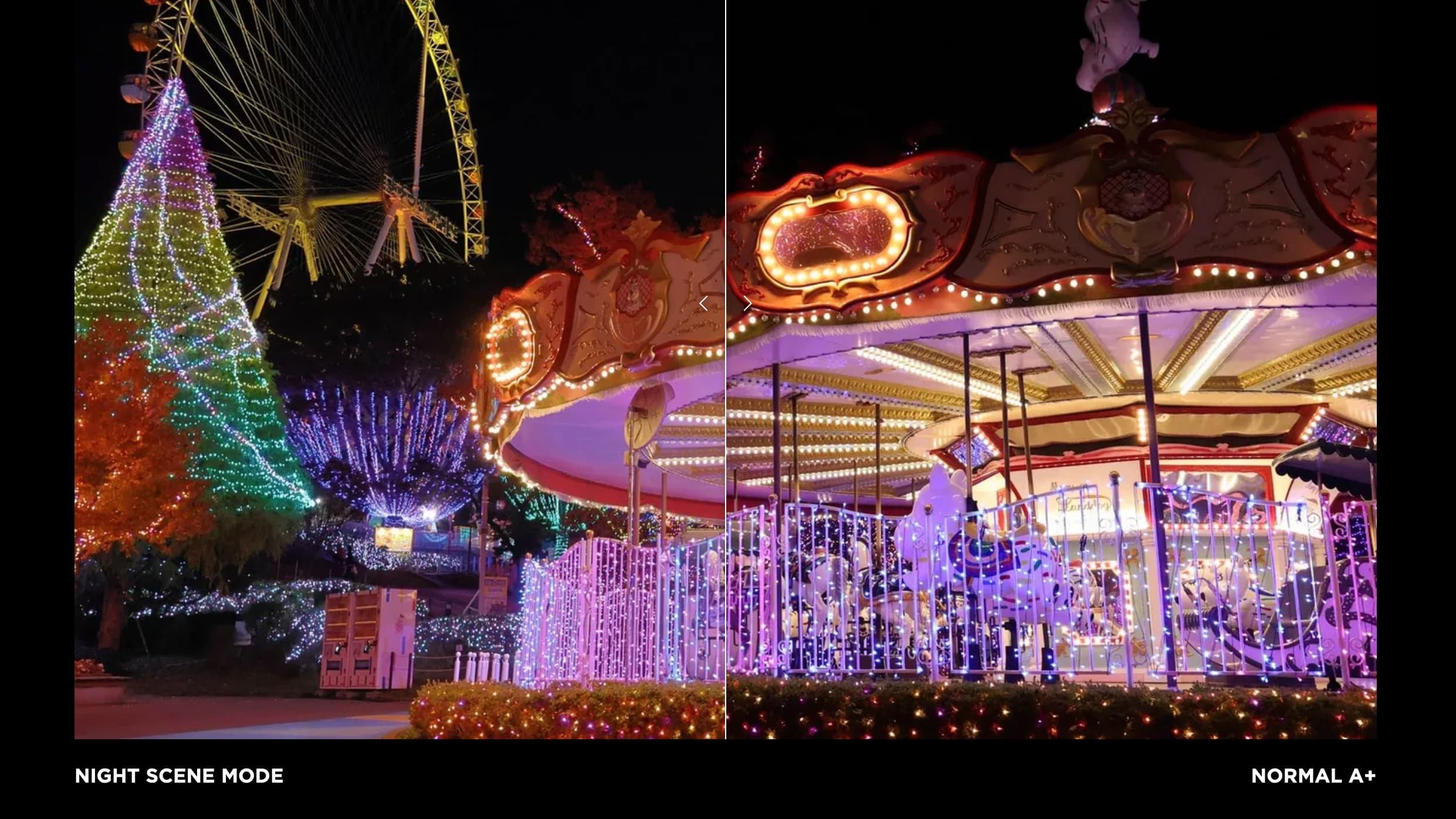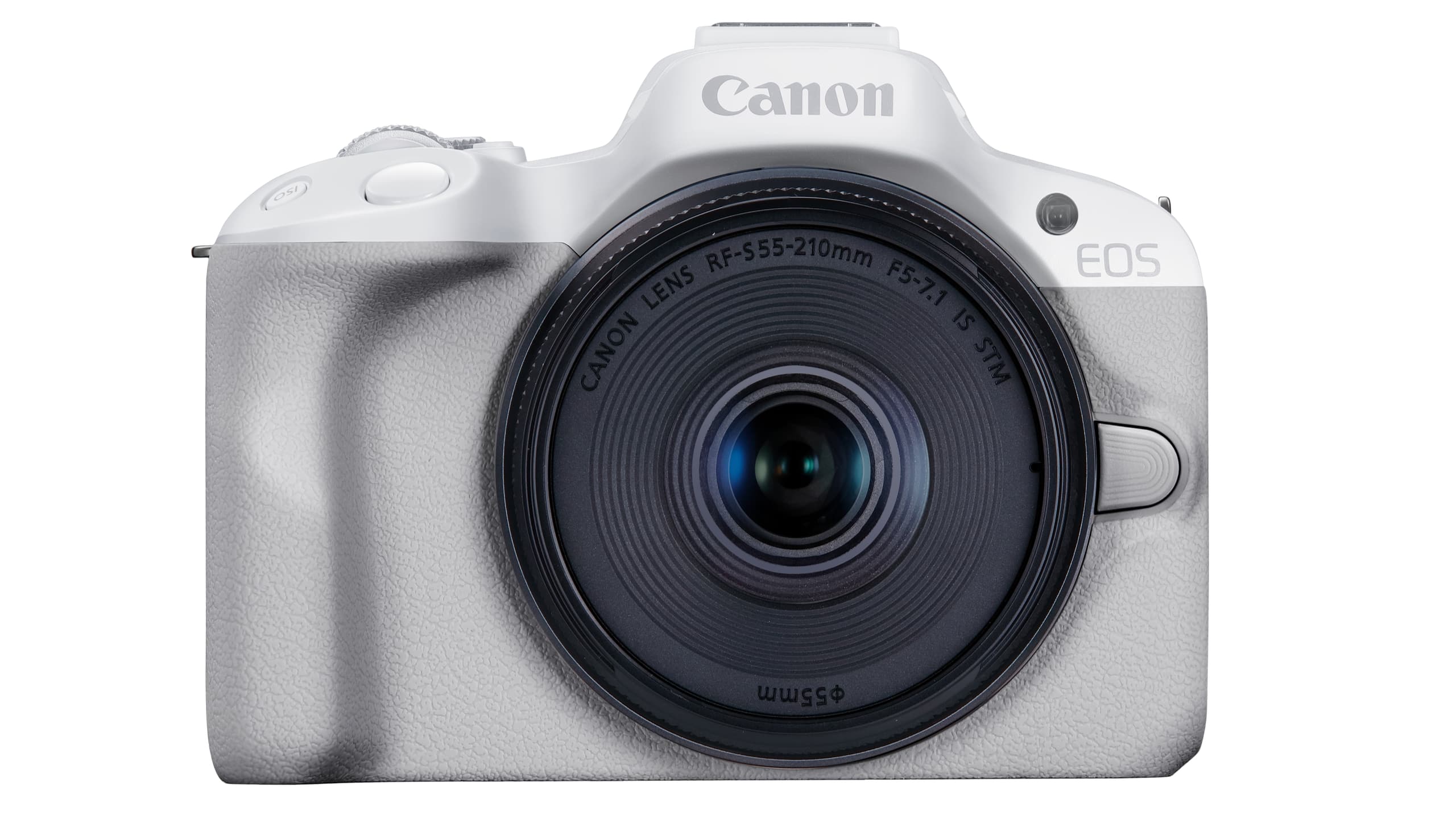Canon EOS R50 vs M50 Mark II
They look alike and are aimed at the same users: Canon EOS R50 vs M50 Mark II, which is best?

The Canon EOS R50 vs M50 Mark II comparison is the most direct head-to-head in the manufacturer's current lineup.
Canon is targeting new users, hybrid stills and video creators, and smartphone upgraders with both of these cameras. Both are small and light, inexpensive to buy and designed with beginners and novices in mind. However, one represents the future, the other is the end of a line – but there's more to the Canon EOS R50 vs M50 Mark II discussion than newness alone.
The EOS M line has always sold well but has never been particularly popular with reviewers because of its amateur orientation, sometimes very plasticky build, and its unique EF-M mount which has proved an evolutionary cul-de-sac. There is no upgrade path for owners of EOS M lenses.
The most successful and best (in our opinion) body is the Canon EOS M50 and the more recent Canon EOS M50 Mark II update, because of its compact size, usability, electronic viewfinder and realistic pricing.
And this is the same market that the new Canon EOS R50 is aimed at. In some ways, you could consider the R50 as a 'reboot' of the M50, but with Canon’s more modern mirrorless RF lens mount – which greatly increases the upgrade options and lens choices in the future. The EOS R50 also has greatly improved autofocus and video capabilities.
Both cameras can be counted among the best cameras for beginners and perhaps the best cameras for travel (though the R50 badly needs a wide-angle lens option). But if you want the best camera for vlogging or the best 4K camera for video, the R50 streaks ahead of the aging and more limited EOS M50 II.
The EOS M50 II is still on sale, it’s cheaper to buy and (for now, at least) has a greater choice of lenses to match its APS-C sensor. It might offer all you need and more, particularly if your main interest is photography rather than video.
So is the Canon EOS M50 II still worth buying, or is the EOS R50 such a huge step forward that it’s a no-brainer? Let’s examine things in detail…
Canon EOS R50 vs EOS M50 II
Why you can trust Digital Camera World
1. Sensor
• Canon EOS R50: 24.2MP APS-C CMOS
• Canon EOS M50 II: 24.1MP APS-C CMOS
Both cameras have 24MP APS-C CMOS sensors. The 0.1MP apparent increase for the EOS R50 is not significant and probably represents a minor change in the sensor design, since it is the same one used in the recent Canon EOS R10. The key point about these sensors is their APS-C format; this introduces a crop factor that affects the lens choice, as we’ll see shortly. Resolution-wise, there’s nothing to choose between these two cameras.
2. ISO range
• Canon EOS R50: ISO100-32,000, exp ISO100-51,200
• Canon EOS M50 II: ISO100-25,600, exp ISO100-51,200
There’s very little difference in the ISO range, either, suggesting that the sensor design may be largely unchanged. The EOS R50 does have a newer and more powerful Digic X processor, which may explain its slightly higher native sensitivity. The R50 also has a clever-sounding Advanced A+ night scene mode, which can merge multiple images shot in quick succession, for lower noise and better image quality in low light.
3. Autofocus
• Canon EOS R50: 4,503-point Dual Pixel CMOS AF II, Digic X processor, 651 zones
• Canon EOS M50 II: 3,975-point Dual Pixel CMOS AF, Digic 8 processor, 25 zones
Here’s where the R50’s newer technology and faster processor makes a big difference. The number of AF points isn’t much higher (both cameras offer plenty), but the R50 can split the scene into a much higher number of individual zones and it boasts more sophisticated subject recognition and tracking capabilities. It also offers in-camera focus bracketing and ‘depth compositing’ for close-ups.
4. Continuous shooting
Canon EOS R50: 12fps (electronic first curtain) 42 JPEG / 7 RAW, 15fps (electronic) 28 JPEG / 7 RAW
Canon EOS M50 II: 10fps, 36 JPEG / 10 RAW
The EOS R50 and M50 II are remarkably speedy for entry level cameras, but there’s a catch: both have very limited buffer capacities, so you will only be able to shoot for a couple of seconds at full speed before the camera slows down – and for less than a second, if you shoot RAW files. So while the R50 has a small speed advantage, neither camera is very good at burst shooting.
5. Video
• Canon EOS R50: Full width 4K 30p oversampled from 6K, up to 1hr recording
• Canon EOS M50 II: Cropped 4K 25p, no Dual Pixel CMOS AF in 4K
The Canon EOS M50 II can shoot 4K video, but only with three serious restrictions: 1) its maximum frame-rate is 25fps, 2) it crops even further into the frame, so your lens’ angle of view becomes tighter, and 3) you lose the speedy Dual Pixel CMOS AF, which is only available for 1080p video. The EOS R50 remedies all three points, and in particular can capture full-width 4K video at up to 30p (oversampled from 6K, for top quality). It can also shoot Full HD video in up to 4x slow-motion, at 120fps. Both cameras can be used for live streaming, as webcams, and for both horizontal and vertical video. Both have external mic and HDMI ports, too (albeit micro HDMI in the case of the latter).
6. Lenses
• Canon EOS R50: RF mount, 3 native Canon RF-S (APS-C) lenses 18-210mm + RF (full frame) lenses
• Canon EOS M50 II: EF-M mount, 8 native Canon lenses 11-200mm
It’s out with the old and in with the new! At the time of writing, the EOS M50 II has a much larger range of eight ‘native’ Canon-made EOS M lenses designed specifically for its APS-C sensor, covering focal lengths from 11-200mm (18-320mm in full frame terms). However, we think this is very much the end of the line and there won’t be any more.
The R50, however, has just three ‘native’ Canon-made RF-S lenses – and, at the time of writing, no wide-angle options at all. It can use full frame RF lenses directly, but these are often too big and expensive to be attractive to users of this body. This is just the start, though, and we hope Canon will quickly build up its RF-S line-up, maybe even by cannibalizing its old EOS M lens designs. Both cameras can at least use older Canon EF / EF-S DSLR lenses via an official (and unofficial) adapter.
7. Size and weight
• Canon EOS R50: 116.3 x 85.5 x 68.8mm, 375g
• Canon EOS M50 II: 116.3 x 88.1 x 58.7mm, 387g
The Canon EOS R50 might appear larger in photos, but that’s because of its chunkier look. In fact, it’s no larger than the EOS M50 II – itself a strikingly compact camera – and no heavier, either. Both cameras have 2.36 million dot electronic viewfinders and articulating rear screens, though the one on the R50 has a higher resolution at 1.62 million dots versus the 1.04 million dots of the M50 II's screen. The R50 has a higher-capacity LP-E17 battery, capable of 310 / 440 shots with LCD / EVF viewing, which is a small but useful step up from the 250 / 305 shots of the EOS M50 II.
8. Price
• Canon EOS R50: $799 / £899 / AU$1,299 with 18-45mm kit lens
• Canon EOS M50 II: $699 / £699 / AU$1,299 with 15-45mm kit lens
New Canon cameras very often come in at a pretty stiff launch price, even those aimed at beginners, but the Canon EOS R50 is an exception. Even at launch it only costs $100 more (in the US) than the M50 II, and its superior autofocus and video alone make it easily worth the extra cash. The price differential may be higher in other territories, but the R50 still looks well worth it.
Canon EOS R50 vs EOS M50 II: Conclusions
Very often our comparison articles throw up some interesting differences and distinct pros and cons for each contender. Not this time, though; the only reasons for choosing the Canon EOS M50 II are its slightly lower cost and its initially larger lens range. This looks very much like the end of the line for the EOS M series, though, so it would hardly be an investment for the future. The Canon EOS R50 is an affordable and powerful entry point to the full RF mirrorless ecosystem, and leaves you plenty of upgrade options if and when you outgrow it later. The M50 II might meet your needs today, but leaves you with nowhere to go in the future.
If you found this article interesting, you might want to check out the best Canon EF-M lenses to use with the M50 Mark II, along with the best Canon RF lenses to pair with the EOS R50.
The best camera deals, reviews, product advice, and unmissable photography news, direct to your inbox!

Rod is an independent photography journalist and editor, and a long-standing Digital Camera World contributor, having previously worked as DCW's Group Reviews editor. Before that he has been technique editor on N-Photo, Head of Testing for the photography division and Camera Channel editor on TechRadar, as well as contributing to many other publications. He has been writing about photography technique, photo editing and digital cameras since they first appeared, and before that began his career writing about film photography. He has used and reviewed practically every interchangeable lens camera launched in the past 20 years, from entry-level DSLRs to medium format cameras, together with lenses, tripods, gimbals, light meters, camera bags and more. Rod has his own camera gear blog at fotovolo.com but also writes about photo-editing applications and techniques at lifeafterphotoshop.com





